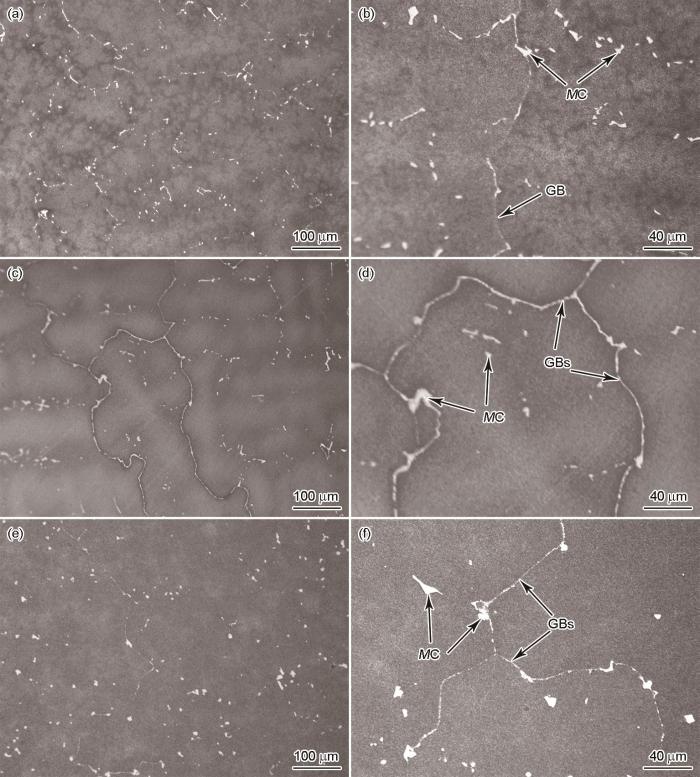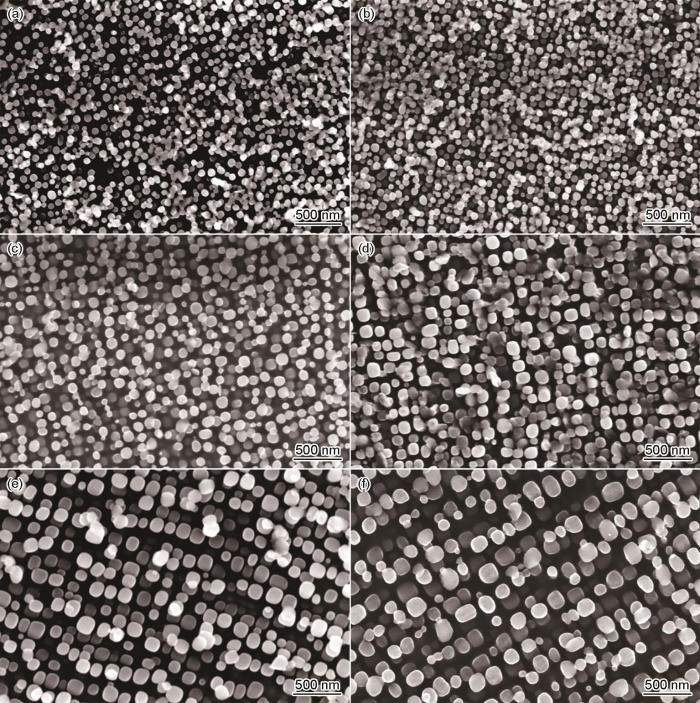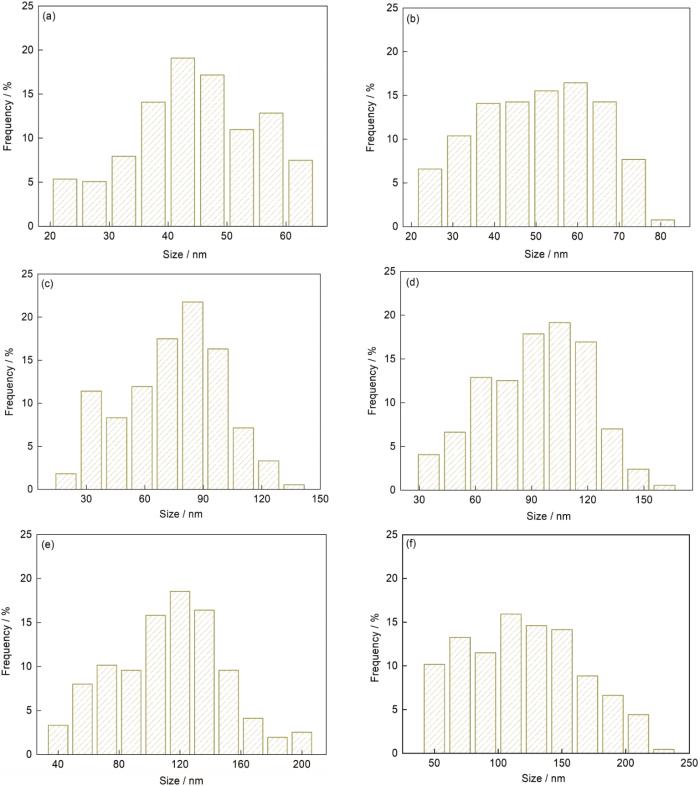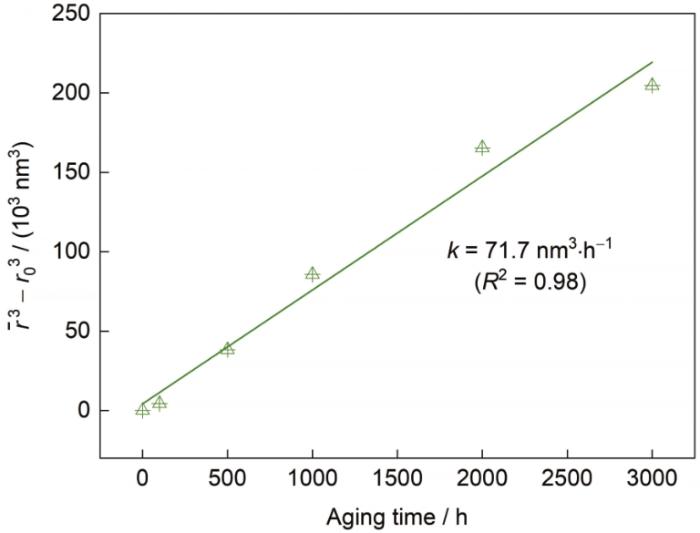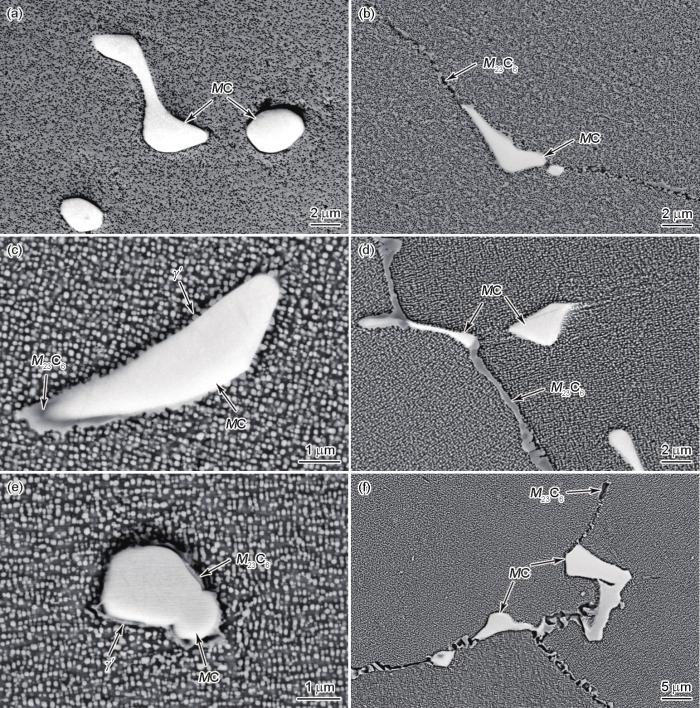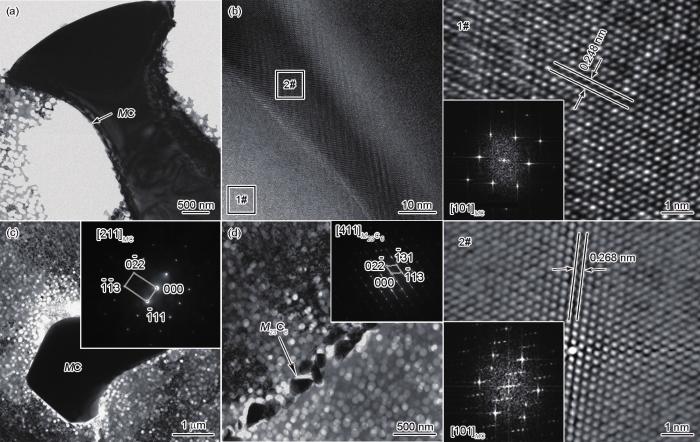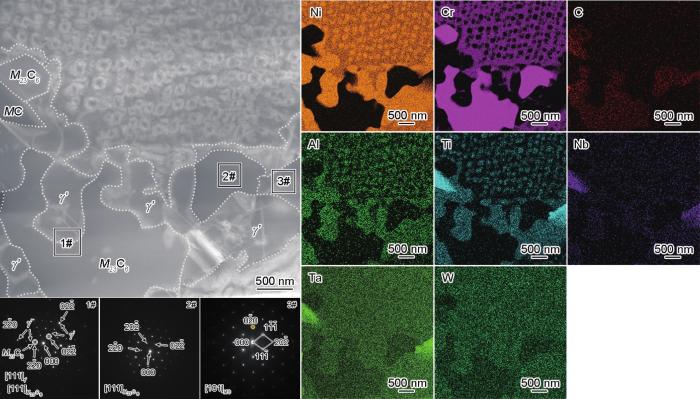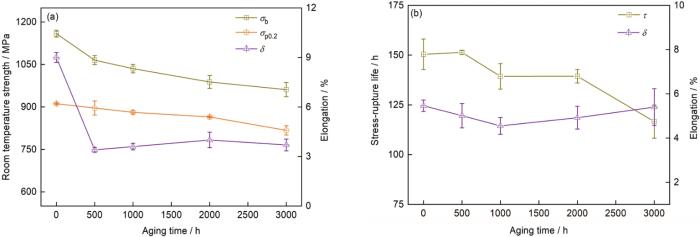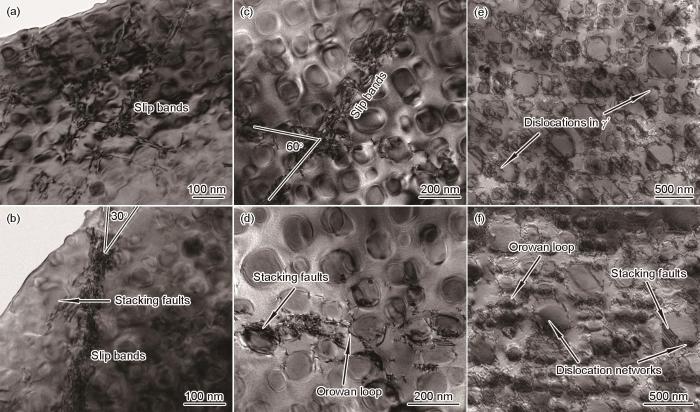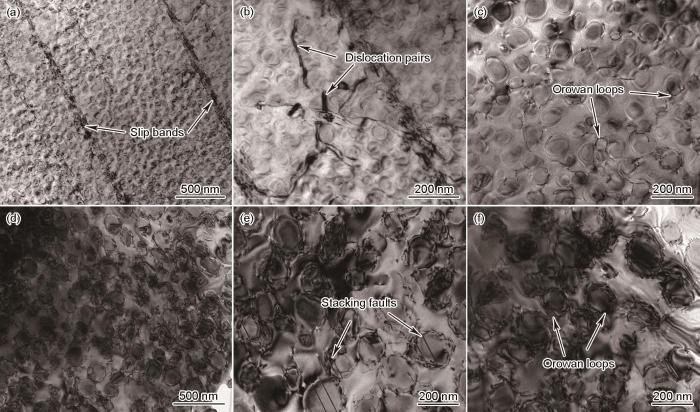镍基高温合金在服役过程中会发生一系列组织演变,如γ'强化相长大、碳化物退化、新相形成,甚至析出拓扑密排(TCP)相[9~12]。此外,热处理态合金中的析出相在长期时效过程中会进一步长大[13,14]。对于等轴晶镍基高温合金,晶界能量较高,更易发生合金相的转变及析出,且转变过程较为复杂。Ou等[15,16]在K4750合金中发现MC碳化物存在MC + γ→M23C6 + γ'、MC + γ→M23C6 + η等退化反应。Liu等[17]对Waspaloy合金进行长期时效研究,发现了相似现象。合金显微组织的变化直接影响力学性能,Cui等[18]研究了一种定向镍基高温合金的组织性能演变,发现γ′相的粗化长大及晶界M23C6碳化物对持久寿命影响显著。Chen等[19]发现基体中析出的TCP相是损害镍基单晶高温合金蠕变性能的主要原因。Chen等[20]研究表明K416B合金长期时效过程中MC碳化物分解为M6C碳化物,降低了合金的室温屈服强度。Bao等[21]对一种变形镍基高温合金研究发现,长期时效过程中γ'相粗化是影响室温拉伸性能的主要因素。对于不同成分体系的高温合金,其高温长期时效组织演变和退化规律存在差异,并且组织演变和退化影响合金力学性能的机制也不同。作为一种新型镍基高温合金,开展典型服役温度(800℃)下K439B合金长期时效组织演变规律及其对力学性能的影响机制研究,对于深入认识该合金具有重要意义。
本工作针对K439B合金测试表征了800℃、3000 h长期时效过程中的显微组织及力学性能,分析该过程中合金相的退化规律,总结了显微组织的演变模型,阐述了组织演变对室温及815℃、379 MPa持久性能的影响,并对拉伸断口附近的位错组态进行表征,讨论了合金的变形机制。
1 实验方法
实验用镍基高温合金K439B由Ni、Co、Cr、Al、W、Ti、Ta、Nb、C及B等元素组成,其中Ti + Al的成分范围为4.7%~5.3% (质量分数)。采用熔模精密铸造法重熔浇注铸态合金试棒。采用非真空热处理炉对K439B合金试棒进行完全热处理,热处理制度为1160℃、4 h、空冷(AC) + 1080℃、4 h、AC + 845℃、20 h、AC。随后开展800℃不同时间的时效实验,最大时长为3000 h。选取不同长期时效时间的试棒加工成力学性能测试用试样,采用3382型电子万能试验机和SATEC M3型高温蠕变-持久试验机分别测试样的室温拉伸和815℃、379 MPa持久性能,测试标准分别为HB5143—1996 《金属室温拉伸试验方法》和HB5150—1996 《金属拉伸蠕变及持久试验方法》。每种性能测试3~5根并取平均值。
切取直径15 mm、长5 mm的热处理态及长期时效态试棒制备金相试样,采用电解腐蚀,腐蚀溶液的体积比为H3PO4∶HNO3∶H2SO4 = 1∶3∶5,电压3 V。同时,在距离力学性能测试断口3 mm处切取直径5 mm、厚0.3 mm试样研磨至60 μm,冲孔并制备透射电镜(TEM)试样,双喷电解溶液为10%HClO4 + 90%C2H6O溶液,电压30 V。采用DM4000M光学显微镜(OM)观察金相组织。采用SUPRA55型场发射扫描电子显微镜(FE-SEM)观察γ′相及碳化物形貌。采用Talos F200X TEM表征相结构及元素分布,采用JEM-2100 TEM表征位错组态,加速电压为200 kV。
2 实验结果
2.1 金相组织
图1所示为K439B合金在800℃长期时效过程中的金相组织。热处理态合金(0 h)及长期时效1000和3000 h后的显微组织无明显变化,不规则的小块状MC碳化物分布于晶界及枝晶间区域,其面积分数分别为1.75%、1.67%和1.53%。随着时效的进行,合金中MC碳化物略有降低。
图1
图1
K439B合金800℃长期时效不同时间后的金相组织
Fig.1
Low (a, c, e) and high (b, d, f) magnified OM images of microstructures of K439B alloy subjected to long-term aging at 800oC for 0 h (a, b), 1000 h (c, d), 3000 h (e, f) (GB—grain boundary)
2.2 γ′ 相
图2所示为K439B合金800℃、3000 h长期时效过程中枝晶干γ′相形貌演变。热处理态合金的γ′相呈球状,尺寸为47.0 nm (图2a)。经过长期时效后γ′相逐渐粗化,数量减少,形貌逐渐立方化。对γ′相颗粒的尺寸分布进行统计,如图3所示。随时效时间的延长,γ′相的尺寸范围增加,其体积分数及平均尺寸见表1。时效100 h后,γ′相的平均尺寸与热处理态合金接近,约为50 nm (图2b)。延长时效时间,γ′相尺寸逐渐增加,时效500 h后,尺寸为74.3 nm,γ′相的形状因子由热处理态的1.09提高至1.34,形貌趋于立方化(图2c)。随着时效时间的进一步延长,γ′相的尺寸继续增大,但增长趋势变缓,在1000、2000及3000 h时γ′相平均尺寸分别为92.4、112.6和120.3 nm。同时,γ′相的形状因子不断增大,但增长趋势也逐渐减慢,分别为1.36、1.39和1.42。
图2
图2
K439B合金800℃长期时效不同时间后枝晶干部位γ′相的典型形貌SEM像
Fig.2
Typical microstructures of γ′ precipitates in the dendrite core of K439B alloy subjected to long-term aging at 800oC for 0 h (a), 100 h (b), 500 h (c), 1000 h (d), 2000 h (e), and 3000 h (f)
图3
图3
K439B合金800℃长期时效不同时间后枝晶干部位的γ′相尺寸分布
Fig.3
Size distributions of γ′ precipitates in the dendrite core of K439B alloy subjected to long-term aging at 800oC for 0 h (a), 100 h (b), 500 h (c), 1000 h (d), 2000 h (e), and 3000 h (f)
表1 K439B合金800℃长期时效不同时间后枝晶干部位γ′相的尺寸、体积分数及形状因子
Table 1
| Aging | Average | Volume | Feret ratio |
|---|---|---|---|
| time / h | size / nm | fraction / % | |
| 0 | 47.0 ± 1.9 | 22.9 ± 1.2 | 1.09 ± 0.03 |
| 100 | 51.8 ± 1.4 | 23.4 ± 0.9 | 1.29 ± 0.02 |
| 500 | 74.3 ± 2.3 | 23.7 ± 1.0 | 1.34 ± 0.01 |
| 1000 | 92.4 ± 2.5 | 23.1 ± 0.8 | 1.36 ± 0.01 |
| 2000 | 112.6 ± 3.5 | 23.2 ± 1.6 | 1.39 ± 0.01 |
| 3000 | 120.3 ± 2.2 | 24.5 ± 1.7 | 1.42 ± 0.01 |
图4
图4
K439B合金800℃长期时效过程中枝晶干γ′相尺寸与时间的关系
Fig.4
Relationship between size of γ′ precipitates in the dendrite core and aging time of K439B alloy at 800oC (
2.3 碳化物
K439B合金中初生MC碳化物在液态熔体凝固期间形核长大,分布于枝晶间及晶界区域。在800℃时效3000 h过程中不同区域的MC碳化物发生了不同程度的退化,采用扫描电镜的背散射电子(BSE)模式对MC碳化物进行了表征,如图5所示。可见,热处理态合金的枝晶间区域分布着白色块状的MC碳化物(图5a),晶界除少量块状MC碳化物外,存在M23C6碳化物镶嵌于γ′相而形成的M23C6/γ′形貌(图5b)。时效1000 h后,枝晶间MC碳化物周围出现少量灰色衬度M23C6碳化物,并粘接γ′相颗粒,如图5c中箭头所指位置,符合MC + γ→ γ′ + M23C6的反应过程[26]。晶界MC碳化物周围则出现较多灰色析出相,衬度略有差异,这是由于M23C6碳化物和γ′相连续析出造成的,析出相含量的增多使得晶界宽度增大(图5d)。延长时效时间至3000 h,枝晶间MC碳化物周围析出更多M23C6碳化物,且γ′相含量增多,部分区域连接形成γ′相层(图5e)。晶界处MC碳化物退化程度增大,γ′相及M23C6碳化物含量增多,晶界处的γ′相尺寸达到600 nm,晶界宽度进一步增大。
图5
图5
K439B合金800℃长期时效不同时间后的碳化物形貌演变
Fig.5
Evolution of carbide distributed in the interdendritic region (a, c, e) and at the grain boundary (b, d, f) of K439B alloy subjected to long-term aging at 800oC for 0 h (a, b), 1000 h (c, d), and 3000 h (e, f)
图6
图6
热处理态K439B合金的碳化物形貌
Fig.6
Carbide in the heat-treated K439B alloy
(a) MC carbide distributed in the interdendritic region
(b) HRTEM image from the edge of the MC carbide (marked with an arrow in Fig.6a) and the atomic-scale HRTEM images from the regions 1# and 2# with corresponding fast Fourier transform (FFT) patterns (insets)
(c, d) MC carbide (c) and M23C6 carbide (d) at the grain boundary with corresponding SAED patterns (insets)
图7所示为800℃时效3000 h后合金晶界附近形貌的TEM像。可见,晶界处存在多种不同衬度的析出相。对其元素分布进行分析,结果表明该区域存在3种元素富集区域:一是富集Ni、Al及Ti元素;二是富集Cr及少量C元素;三是富集Ti、Nb、Ta及C元素。对图中1#、2#及3#位置进行SAED分析(其中1#为两相界面),并综合元素分布可知,3种相分别为γ′相、M23C6碳化物及MC碳化物。γ′相与M23C6碳化物的位向关系为[111] γ′ //[111] M
图7
图7
K439B合金800℃时效3000 h后的晶界析出相及元素分布
Fig.7
Grain boundary precipitated phase, SAED patterns of regions 1#-3#, and EDS compositional mapping of K439B alloy subjected to long-term aging at 800oC for 3000 h
表2 K439B合金800℃时效不同时间后枝晶间及晶界区域M23C6碳化物的含量
Table 2
| Aging time | Interdendritic region | Grain boundary |
|---|---|---|
| h | % | % |
| 0 | - | 20.86 |
| 100 | - | 23.64 |
| 500 | - | 25.98 |
| 1000 | 2.34 | 29.40 |
| 2000 | 6.58 | 36.43 |
| 3000 | 10.19 | 38.93 |
2.4 力学性能
图8所示为800℃时效不同时间后合金的室温拉伸和815℃、379 MPa持久性能。热处理态合金的室温抗拉强度和屈服强度分别为1159.0和911.5 MPa。时效500 h后,室温拉伸强度略有降低,延伸率由热处理态的9.0%降低至3.4%。当时效1000 h时,室温拉伸强度进一步降低。随着时效时间继续延长至3000 h,延伸率变化不大,在3.4%~4.0%之间浮动,抗拉强度和屈服强度分别降至961.3和817.3 MPa,较热处理态分别降低了17.1%和10.3%。图8b为合金815℃、379 MPa持久性能随时效时间的变化情况,热处理态合金的持久寿命为150.4 h,随着时效时间的延长,持久寿命逐渐降低,时效3000 h后,持久寿命为116.6 h,降低了22.5%。热处理态合金815℃、379 MPa持久延伸率为5.5%,时效1000 h时降至4.6%,延长时效时间至3000 h,延伸率略有回升。
图8
图8
K439B合金800℃长期时效不同时间后的力学性能
Fig.8
Room temperature tensile properties (a) and 815oC, 379 MPa stress rupture properties (b) of K439B alloy subjected to long-term aging at 800oC (σb—tensile strength, σp0.2—yield strength, δ—elongation, τ—stress rupture life )
图9所示为室温拉伸性能断口的位错组态。热处理态合金经室温拉伸后,基体中存在一定量的位错滑移带(图9a),且互相交叉成一定角度,2条滑移带呈30°夹角,同时少量γ′相中出现层错结构(图9b)。时效1000 h后,位错仍以滑移带形式为主,滑移带夹角呈60°(图9c),部分位错以Orowan绕过的方式通过γ′相,留下位错环,同时位错运动至γ/γ′界面处,切入γ′相,使得γ′相中堆垛层错的含量略有增加(图9d)。延长时效时间至3000 h,位错运动至γ/γ′界面导致塞积,钉扎γ′相,更多位错切入γ′相形成堆垛层错,并且可观察到部分γ′相被位错切入(图9e)及Orowan位错环的存在,以及由于位错运动在基体通道中出现位错网络结构(图9f)。
图9
图9
K439B合金800℃长期时效不同时间后室温拉伸断口附近位错形貌
Fig.9
Dislocation structures near room temperature tensile fracture surface of K439B alloy subjected to long-term aging at 800oC for 0 h (a, b), 1000 h (c, d), and 3000 h (e, f)
图10
图10
K439B合金800℃长期时效不同时间后815℃、379 MPa持久断口附近位错形貌
Fig.10
Dislocation structures near 815oC, 379 MPa stress rupture fracture surface of K439B alloy subjected to long-term aging at 800oC for 0 h (a-c) and 3000 h (d-f)
合金在室温拉伸及815℃、379 MPa持久变形过程中,随着时效时间的延长和γ′相的粗化,基体中的位错密度增大,位错形貌由在基体中形成滑移变形带为主,向位错切割γ′相转变,以Orowan绕过机制通过γ′相留下位错环,并在γ′相周围塞积,部分切入γ′相形成层错结构,层错存在于γ′相中,未贯穿基体。
3 分析讨论
3.1 显微组织演变规律
镍基高温合金成分复杂,在凝固过程中存在元素偏析现象,热处理无法彻底消除。在长期时效过程中,合金的成分将逐渐趋于平衡,元素扩散导致固态相变发生,合金相组成也接近平衡态。Thornton等[25]研究发现γ′相的粗化向趋于系统总能量最低的方向进行,与界面能和应变能有关。图11所示为K439B合金800℃时效3000 h过程中的组织演变示意图。γ′相在形核析出时应变能大而界面能小,热处理态γ′相呈球状分布(图2a和11a),时效过程中为了降低γ/γ′两相共格应变能,γ′相逐渐向立方化转变(图2、11b和c)。同时,该过程中γ′相颗粒的粗化符合Ostwald熟化机制[24],γ′相尺寸的三次方与长期时效时间具有良好的线性关系(图4),符合LSW理论。
图11
图11
K439B合金800℃时效不同时间的显微组织演变示意图
Fig.11
Schematics of microstructural evolution of K439B alloy during long-term aging at 800oC for 0 h (a), 1000 h (b), and 3000 h (c) (ID—interdendritic region)
由于晶界位置的晶体结构不规则,排布比较散乱,为元素的扩散提供了能量及通道,相变优先在该处发生。热处理态合金晶界分布少量MC碳化物,并存在M23C6碳化物镶嵌于γ′相现象,形成M23C6/γ′形貌,而枝晶间仅存在MC碳化物(图5b和图11a)。时效1000 h后,晶界MC碳化物发生退化,析出更多M23C6碳化物及γ′相,同时热处理态已有的M23C6碳化物长大;枝晶间MC碳化物发生轻微退化,其周围形成少量M23C6碳化物和γ′相颗粒(图5c和11b)。时效时间延长至3000 h后,晶界及枝晶间MC碳化物退化程度加重,晶界析出更多M23C6碳化物,已有的M23C6碳化物进一步长大;枝晶间MC碳化物退化致使其周围形成更多的M23C6碳化物及γ′相,部分区域形成γ′相层(图5e和f,图11c)。
3.2 变形机制分析
γ′相是K439B合金的主要强化相,随着时效时间延长而逐渐长大,位错的运动方式随之发生改变。fcc结构金属的密排滑移面为{111},变形开始后,a / 2<101>位错在基体通道中滑移,a / 2<101>位错对切割γ′相并在滑移面上形成滑移带[15]。热处理态K439B合金的γ′相尺寸较小(图2a),室温拉伸后,基体中存在一定量的位错滑移带(图9a),位错不均匀地分布于基体,产生局部硬化,合金室温强度较高。热处理态合金持久变形后除产生一定量的滑移带外,少量位错以Orowan绕过机制通过γ′相,留下位错环(图10c),位错难以切入γ′相,γ′相的阻碍作用较大,且基体通道较窄,位错不易通过,增加了强化效果,合金持久寿命较优。时效1000 h后,γ′相的尺寸长大且逐渐立方化(图2d)。室温拉伸后基体中仍存在一定的滑移变形带,且部分位错切入γ′相(图9d),γ′相对位错的阻碍作用降低,拉伸强度降低。进一步延长时间至3000 h,室温拉伸变形时仍有位错以Orowan绕过机制运动,在γ′相周围留下位错环(图9f)。同时a / 2<101>位错在基体通道中滑移以及部分a / 2<101>位错在γ/γ′界面处分解形成a / 6<121>和a / 3<121>不全位错,后者切入γ′相,形成层错结构,含有层错缺陷的γ′相难以阻碍后续位错的运动,进而使得合金强度降低[28]。持久变形后断口γ′相中存在的层错结构不利于合金强度,降低了持久寿命。
此外,当位错以Orowan绕过方式运动时,在基体中受到的滑移阻力τ可表示为[29]:
式中,μ为剪切模量,b为Burgers矢量模,h为γ基体通道宽度。合金长期时效过程中γ′相逐渐长大,但体积分数基本不变,γ′相数量逐渐较少,基体通道变宽,对位错的阻力下降,合金强度降低。
热处理态合金变形断口中γ′相尺寸较小,位错以在基体中形成滑移变形带为主(图9a和10a),使得基体产生局部硬化,此外晶界处颗粒状M23C6碳化物嵌于γ′相(图5b),具有晶界强化作用,使得晶界位置在变形时不易开裂,延长了合金的断裂时间,此时室温拉伸和持久的延伸率较高。时效1000 h后,γ′相长大(图2d),对位错的阻碍能力减弱,同时晶界M23C6碳化物含量增加,晶界宽度增加(图5d),位错易在此处塞积,造成应力集中,合金较快断裂,延伸率降低。进一步延长时效时间后,γ′相粗化,γ基体通道宽度增大(图2f),位错更易通过;同时合金中析出了更多M23C6碳化物(图5e和f),M23C6碳化物的形成消耗了Cr元素,降低了基体强度,塑性变形更易进行,持久延伸率略有提高[30]。
4 结论
(1) 热处理态K439B合金γ′相呈球状分布,尺寸为47.0 nm,800℃长期时效过程中γ′相逐渐长大并趋于立方化,γ′相的长大符合LSW理论,粗化速率为71.7 nm3/h。
(2) 热处理态K439B合金晶界存在MC及M23C6 2种碳化物,而枝晶间仅存在MC碳化物。长期时效过程中晶界和枝晶间MC碳化物发生退化,M23C6碳化物析出含量增加。
(3) 800℃时效3000 h后,K439B合金晶界析出相为MC碳化物、γ′相及M23C6碳化物,γ′相与M23C6碳化物的位向关系为:[111] γ′ //[111] M
(4) 热处理态K439B合金中位错运动主要形成滑移变形带,合金的室温抗拉强度和屈服强度分别是1159.0和911.5 MPa,815℃、379 MPa持久寿命为150.4 h。长期时效后γ′相尺寸增加,位错的运动方式以切入γ′相形成堆垛层错为主,合金的室温拉伸强度和815℃、379 MPa持久寿命随着时效时间延长逐渐降低。
参考文献
New materials enable unprecedented improvement in turbine performance
[J].
δ Phase precipitation in Inconel 718 and associated mechanical properties
[J].
Effect of heat treatment on the microstructure and mechanical properties of Inconel 718
[J].
Microstructure and typical properties of cast Ni-based superalloy K439B
[J].Typical microstructure, long-term aging microstructural stability at 800 ℃ and main properties of cast Ni-based superalloy K439B were introduced and compared with that of K4169 and CM939 alloys. The results show that the K439B alloy has good comprehensive properties, and its tensile properties and temperature capability are equivalent to that of the CM939 alloy. The oxidation resistance and salt-coated hot-corrosion properties of the K439B alloy are better than that of the K4169 alloy at 800 ℃, and its gas hot-corrosion property is similar to that of the K4169 alloy at 800 ℃. Meanwhile, the K439B alloy is unsusceptible to the welding hot cracking. It has been applied in the casting of hot-section components for advanced aero engines and gas turbines such as combustor case, preswirl nozzle and nozzle ring, etc.
铸造镍基高温合金K439B的组织及典型性能
[J].介绍了铸造镍基高温合金K439B的典型显微组织、800 ℃长期时效组织稳定性和主要性能,并与K4169和CM939合金进行了比较。结果表明,K439B合金的拉伸性能和承温能力达到CM939合金水平,800 ℃抗氧化性能和涂盐热腐蚀性能优于K4169合金,800 ℃燃气热腐蚀性能与K4169合金相当,具有较低的焊接热裂纹敏感性,综合性能优良,已经在燃烧室机匣、预旋喷嘴、喷嘴环导向器等先进航空发动机和燃气轮机热端部件上获得应用。
Morphological evolution of γ' precipitates in superalloy M4706 during thermal aging
[J].
High temperature creep behavior of a cast polycrystalline nickel-based superalloy K465 under thermal cycling conditions
[J].
Influence of long-term aging on microstructural stability and performance of DD6 superalloy
[J].
Effect of Re on mechanical properties of single crystal Ni-based superalloys: Insights from first-principle and molecular dynamics
[J].
Effect of long time service exposure on microstructure and mechanical properties of gas turbine vanes made of IN939 alloy
[J].
Comparison of microstructural stability of IN939 superalloy with two different manufacturing routes during long-time aging
[J].
Effect of grain boundary precipitates on the stress rupture properties of K4750 alloy after long-term aging at 750oC for 8000 h
[J].
The nucleation and growth of η phase in nickel-based superalloy during long-term thermal exposure
[J].
Effect of thermal exposure on the microstructure and stress-rupture properties of a directionally solidified superalloy
[J].
Tailoring the creep properties of second-generation Ni-based single crystal superalloys by composition optimization of Mo, W and Ti
[J].
Effect of long-term thermal exposures on tensile behaviors of K416B nickel-based superalloy
[J].
Effects of long-term aging on microstructure and properties of a tungsten bearing heat-resistant alloy
[J].
The kinetics of precipitation from supersaturated solid solutions
[J].
The effects of different alloying elements on the thermal expansion coefficients, lattice constants and misfit of nickel-based superalloys investigated by X-ray diffraction
[A].
Review progress in Ostwald ripening theories and their applications to the γ'-precipitates in nickel-base superalloys Part II Nickel-base superalloys
[J].
Large-scale simulations of Ostwald ripening in elastically stressed solids: I. Development of microstructure
[J].
Degeneration process and mechanism of primary MC carbides in a cast Ni-based superalloy
[J].
铸造镍基高温合金中初生MC碳化物的退化过程和机理
[J].
The decomposition behavior of primary MC carbide in nickel base directionally solidified superalloy DZ444
[J].
定向凝固DZ444镍基高温合金初生MC碳化物的分解行为
[J].
Creep resistance of CMSX-3 nickel base superalloy single crystals
[J].




